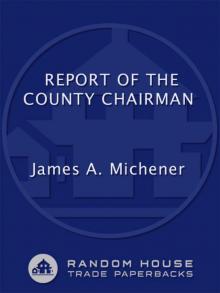- Home
- James A. Michener
This Noble Land: My Vision for America Page 7
This Noble Land: My Vision for America Read online
Page 7
But there was gloom among the forty thousand employees who found themselves without jobs on the third day of the new year and with dismal prospects for replacing them. Belatedly, we are beginning to realize that such cuts are going to hit even families whose incomes range in the $70,000–$120,000 bracket. And if the husband does find a job, it will be at a salary much reduced from what the family was accustomed to. In that case, the wife, if she is not already working, must also go to work to contribute a second salary. A deplorable result is the latchkey child, who finds no one at home when he returns from school. Families in this group are severely hurting, with many unable to afford to send their children to college.
News about the downsizing of companies has become common in recent years, and its significance is always the same. Like AT&T, the overall American economy is doing fine, but its employees are not—their earnings are not even keeping up with inflation. The nation’s total income is rising, but 97 percent of the increase falls into the hands of the wealthiest 20 percent of the population. Money is not ‘trickling down.’ The spectacular rise in the Dow Jones industrial average means that citizens who already possess wealth and have it wisely invested have grown richer. The stock market directly affects only a small percentage of the population, although added wealth injected anywhere in the economic system occasionally produces some carryover to the general population. But the basic truth of a rising stock market today is that the rich become richer playing games in the market while the poor remain where they were or become even poorer. The joy of the man who profited from the rise in the Dow Jones should not blind us to the grief of the man of fifty with a family to support who is suddenly without a job.
I am reminded of that universal truth voiced by Oliver Goldsmith:
Ill fares the land, to hastening ills a prey,
Where wealth accumulates and men decay.
Changes in American life during the past three decades seem to prove the accuracy of the poet’s lament. During recent years my attempts to help friends find new jobs have accomplished little, and at the same time I see that my graduate students who are soon to enter the labor market view with apprehension their chances of finding jobs commensurate with the years they have spent preparing for them. I do not find, in American life generally, much awareness of the tragedy of unemployment. We commiserate with the homeless and weep for the young people dying of AIDS, but we do not allow the brutal facts of mid-level unemployment to sink into our conscience. Another of Goldsmith’s couplets is equally applicable to the situation:
But a bold peasantry, their country’s pride,
When once destroy’d, can never be supplied.
The economic revolution of recent times has gone far toward destroying our ‘bold peasantry,’ among them the factory worker who has spent years building his skills and his value to his company but who now finds he is no longer needed because his factory has fled either eastward to Asia—Taiwan, Hong Kong, Singapore, Korea—or south to Mexico. If this drift continues much longer, I can foresee only a radical redefinition of American life.
The closest historical analogy to our perilous position today is found in sixteenth-century Spain, which ruled much of the world and controlled not only the rich Iberian Peninsula but also much of central Europe, including Austria and the Netherlands. Commerce flowed freely among this group of nations; industries in one country balanced and supported those in another, and there was a rich symbiotic interrelationship. But what impresses me most about Spain in those days was that it had one of the strongest peasant cadres in the world, stalwart men and women who had mastered agriculture, wine making, leather curing, iron fabrication and the sensible harvesting of forested lands. In 1520 they excelled in all these fields and had established a high standard by which workers in other countries were judged; cordovan leather, a Toledo blade and sherry wine were known and treasured throughout the civilized world. Spain stood preeminent in the stability of its national economy, its good government under the Hapsburgs and its military genius.
In the Spanish colonies of Peru and Mexico, the conquistadores discovered silver and gold. Yearly caravels from Peru began to sail up the Pacific coastline to Panama, where mule trains hauled the precious metals across the isthmus to be loaded onto the great treasure fleets that crossed the Caribbean and Atlantic with the treasures from Peru and Mexico, depositing them at the mouth of the Guadalquivir River.
What this newfound wealth from the colonies did was to flood the economy in Spain with unearned currency. Prices for everyday goods skyrocketed and the peasants were diverted from their normal tasks. Spaniards now bought things instead of making them. The thrifty farmers no longer worked their fields. Much of the mineral wealth mined in Peru and Mexico passed quickly through Spain to finance its endeavors on foreign battlefields. The decline of Spain began with this ungoverned influx of unearned wealth, which caused the trades and industries on which Spain had depended for her greatness to fall into disuse.
France and England were fortunate that in neither their homelands nor their colonies did they discover gold. There was no sudden bonanza within their economies; the peasants continued to harvest their fields and the workmen to pursue their trades. They enjoyed a slow, orderly and controlled growth, and within a century both nations were much stronger than profligate Spain, whose flood of unearned income brought it to stagnation, if not to ruin.
Americans should study the Spanish phenomenon—falling from supremacy down to third-rate in one century—because we are making the same errors that weakened Spain. The gold and silver mines that we have discovered are the factories in Japan, Korea, Taiwan, Hong Kong, Singapore, and Mexico. They make the consumer goods our once famous factories no longer bother with. Like sixteenth-century Spain, we buy the goods we want from abroad and allow our bold peasantry to languish without jobs. We are able to purchase so much from abroad because our tax system has constantly enriched our upper classes so that they can afford the foreign goods.
Visit my street in a typical American suburb. Parked in the driveways are cars and small trucks made in Japan. In my house the sound system that plays the music I love is totally Japanese. I’ve tried other makes and they cannot be relied upon to function more than half a year; the Japanese electronics go on forever, and if replacement parts are ever required, they are available and easily installed. My closet is filled with all kinds of clothes made in East Asia at bargain prices; my shoes are from either Spain or Asia. My tennis shoes are from Taiwan, as are my caps, emblazoned with the names of professional U.S. sports teams. My electric lights are made abroad, as are my inexpensive bedroom clock radios. My little camera is foreign-made, as is the film I use. My neighbor has a wonderful video camera for making movies and, minutes later, showing them on a family screen. Both the camera and the screen came from Japan. I sometimes feel that anything I pick up in my home will bear, on scrutiny, the label MADE IN JAPAN. Or MADE IN TAIWAN, MADE IN KOREA.
The young lady across the street who works as a librarian occupies a neat condo in which the kitchen is an international gourmet festival. There are cans of sliced mango from Thailand, hearts of palm from Brazil and ginger-sauce dressing from Canada. She has stocked tins of jack mackerel from Chile, water chestnuts from China and jars of marinated artichoke hearts and capers from Spain.
In heavy industry the same buy-abroad situation prevails. What used to be made in American steel factories is now made in Asia. The wood products that we used to fabricate in Oregon and Washington are now made in the woodworking factories in Asia. When I worked in Poland I was surprised to find a factory that operated overtime. When I asked what they were making, the foreman explained: ‘We found a vacuum in American industry—golf carts. Everyone uses the product but nobody in the States bothers to make them anymore. We ship them by the thousands.’
Walter Cronkite and I met the workers who were building him a sailboat—in Taiwan. Wherever I went in Asia it seemed that some enterprising entrepreneur was building things for shipm
ent to the States. Most curious was an entire village in China whose talented masons were carving panels in stone for the decoration of expensive American hotels.
This constant flight of American industry to foreign sites was very apparent to me when I lived in Alaska. In my small town, a village set among forests, the principal industry was a thriving Japanese mill in which recently felled trees were ground into a liquid pulp. Then, right into the middle of town via the small river that ran through it, came huge ships from Japan and Korea, which siphoned the pulp into their holds and ferried it back across the Pacific. There it was transformed into high-quality specialty paper, which in turn was brought back for sale in the United States.
I witnessed the same phenomenon with the ore mines in Alaska and especially with our oil reserves in the high Arctic. Everything produced from the soil was being shipped overseas to Asia, where human intelligence—which Japan and Korea and especially Singapore seemed to have in abundance—was applied to the pulp, the ores, the timber and the petroleum to make products to be sold in the United States.
One morning as I watched a huge pulp tanker bound for a paper factory in Japan pass an oil tanker headed for a refinery in Taiwan, I was struck by the economic reality: I saw that Alaska was behaving like an underdeveloped nation. We send our natural products abroad as raw materials, and the brilliant minds of Asia convert them into goods that we buy back. We make little of our own. We’ve become international parasites.
Proof of this change in our national direction can be seen in the proliferation of shopping malls along the margins of established towns and cities. These ornate centers are really cathedrals of consumerism, and their allure is irresistible. I see many adverse factors in the growth of malls. They disrupt traditional shopping patterns and often cause the center of the town or city to deteriorate to the loss of everyone.
The malls have a negative influence on children, who come to regard a visit to the mall as a cultural oasis and a social pleasure when in reality it dulls and deadens the youthful imagination. When I was a boy a trip into the center of Philadelphia was an exhilarating experience, for not only were the great department stores—Wanamaker’s, Gimbels, Strawbridges, Lits—ranged side by side, but there was also the theater, the Keith’s vaudeville house, the art museums, the churches and the parks, and the cultural riches of the university and the bookstores. In contrast, what the average mall offers is only consumerism.
Economically, the mall prospers by importing low-cost goods manufactured abroad and selling them at bargain prices, often to the detriment of local producers. There are bargains to be found in the malls, but they come at a very high overall cost to our nation. But since malls are effective distributors of goods at attractive prices, it looks as if they will not only continue at their present level but also graduate into entirely different kinds of merchandizing centers. Already some of the more notable malls are beginning to offer some cultural benefits like big bookstores, which provide comfortable chairs for the customer who is only browsing and who wants to dip into an attractive book to see if it is worth purchasing. Such stores also offer small snack bars or coffee shops. Some malls provide space for an established church to move onto the premises, and in other malls wandering minstrels and jugglers add immense charm to the business of buying things. I have seen still others that provide work space in which local artisans can ply their trade and perhaps sell their work.
But on balance I find the mall, especially in the mid-sized city, a negative influence. It is a fitting symbol of our transformation from a nation of producers into a horde of consumers. This transformation has resulted in many evil consequences.
Because we import so much unnecessarily, we have accumulated a huge foreign trade imbalance. Almost without being aware of the change, we have shifted from being a creditor nation that others used to owe for the fine products we sold them—our steel, our automobiles, our farm implements—to being the top debtor nation in the world.
Saddled with tremendous and growing debt, we are being goaded into making stupid decisions as to how we might reduce it. Just as we moved too swiftly in accumulating it, I fear we shall react foolishly in trying to reduce it. New laws being discussed whereby money now spent on child care, aid to dependent children and food for the poor would be terminated are disastrous steps in the wrong direction.
In electing to buy from abroad rather than producing the goods in our home industries, we have forced many of our own manufacturers into near bankruptcy or the abandonment of their factories.
We have allowed or even invited our home-based factories to close down mills here and open low-wage subsidiaries abroad. The history of the maquiladora factories just across the Rio Grande in Mexico is an example of the penalties we have imposed upon ourselves. Often built with American capital and utilizing manufacturing procedures invented and perfected in the States, these Mexican factories, able to hire Mexican workers at $1.46 an hour, can undersell and bankrupt American plants that have to pay American workers $10 and more an hour. The final product created by this semislave labor is then welcomed back, tax-free, into the American markets. These factories are of great benefit to Mexico’s economy, but they are nevertheless an example of industrial suicide sponsored by our own government.
These radical changes have gone far toward destroying the vitality of the American labor movement and removed from effective public life a segment of society that, despite its faults, did goad our leaders into making sensible rules regarding the working class. Absent the countervailing force of the unions, our country has made horrendously wrong decisions concerning the relations between capital and labor; the twelve years of ‘Reaganomics’ under Presidents Reagan and Bush were disastrous for labor. The loss of labor’s powerful restrictive voice has weakened the nation.
A major penalty we incur when we shift from producer nation to consumer is spiritual, and here I must apologize for inserting into this discussion an intensely emotional credo to which I have always subscribed.
I believe a positive good results when a man assumes the obligation of a regular job; he spends at least five days a week at his tasks and has the fulfilling pleasure of knowing that he is making a product of use to his society, his town and his family. I believe this has been true since the beginning of civilization. I cannot presume to speak for women, but I do not doubt that they have the same sense of satisfaction in a job well done.
What is there in daily work that creates such a sense of well-being? I suppose it stems from memory reaching far back to a time when work meant survival, and when the avoidance of work brought disaster to oneself or to family or community. The same spiritual reward for a job well done motivated the early settlers in America, who had to clear fields for growing crops and to build log cabins for their families. By extension, I think that more recently the same motivations and satisfactions operated among the workers in the steel mills of Pittsburgh, the auto plants in Detroit or in the building of irrigation ditches in Colorado and Wyoming.
I believe it to be an obligation of the state to organize society so that the maximum number of citizens can have wage-producing work that enables them to support their families and maintain their self-esteem. The failure of the leaders who organize and manage our economy to assure such work leads to a nation on the decline; if this prolonged failure to provide jobs persists, radical changes will sweep the land. I suspect that if a wife watches her husband fail week after week to find work, or if she herself cannot find a job, before long she might well become more revolutionary than he, for she will see a monstrous wrong in the failure of society to protect her children, and she will set out to correct it and urge her husband to do the same.
I would be less than honest if I did not admit that our citizens do obtain certain benefits in this shift from producing to consuming. They can buy with confidence men’s clothing made in—expensively overseas and for sale here at low cost as well as the foreign-made electronic products that work and are reasonably priced. The f
oods we import because our farmers are no longer producing them at home are delicious and worth what we pay for them. The rich variety of choice, the reliability of the items made abroad and the relatively low prices are all considerable assets, and I would not easily surrender them. But I see with painful clarity that prolonged reliance upon the workers in foreign lands—the steel fabricators, the shoemakers, the tailors—is corrupting the American spirit. We pay a fearful penalty for the bargains we enjoy.
Even so, I could approve our continuing to import many of the goods that enhance our life if we were allowed to sell our products abroad in an even, well-regulated exchange because that would mean jobs for our workers producing those goods. But it is a difficult situation because some foreign nations restrict the import of our products.
As usual, when our nation makes a radical shift in our economy the heaviest burden falls on those least qualified to adjust to the new order. The radical shifts in our economic policies have had particularly adverse consequences for three categories of the very poor: the African Americans, the Hispanics and the so-called poor whites. Figures provided by the Bureau of Labor Statistics reveal that 6.1 percent of the labor force—men and women sixteen years and older who were trying to find work—were unemployed in 1994, but blacks in this group had more than twice the percentage of unemployment (11.5 percent) as whites (5.3 percent), with Hispanics (9.9 percent) also showing a heavy disproportion.
A closer look shows the burden on certain age groups is especially onerous. Teenagers aged sixteen and seventeen are hit hardest: 19.9 percent of those trying to find work cannot. For African American teenagers in this age group the percentage climbs: 39.3 percent of the males and 32.9 percent of the girls are unemployed. Hispanic teens don’t fare much better: 33.3 percent of the Hispanic male labor force and 29.7 percent of the Hispanic girls are unemployed. White male teens show an 18.5 percent rate of unemployment and white girls, 16.6 percent.

 Mexico
Mexico The World Is My Home: A Memoir
The World Is My Home: A Memoir Sayonara
Sayonara Chesapeake
Chesapeake The Novel
The Novel Rascals in Paradise
Rascals in Paradise Return to Paradise
Return to Paradise Presidential Lottery: The Reckless Gamble in Our Electoral System
Presidential Lottery: The Reckless Gamble in Our Electoral System The Source
The Source Poland
Poland Space
Space Caravans
Caravans Creatures of the Kingdom: Stories of Animals and Nature
Creatures of the Kingdom: Stories of Animals and Nature Iberia
Iberia Hawaii
Hawaii The Watermen: Selections From Chesapeake
The Watermen: Selections From Chesapeake Report of the County Chairman
Report of the County Chairman The Covenant
The Covenant The Bridges at Toko-ri
The Bridges at Toko-ri Matecumbe
Matecumbe Journey: A Novel
Journey: A Novel Centennial
Centennial Sports in America
Sports in America Texas
Texas Miracle in Seville
Miracle in Seville This Noble Land: My Vision for America
This Noble Land: My Vision for America Tales of the South Pacific
Tales of the South Pacific Bridges at Toko-Ri
Bridges at Toko-Ri Space: A Novel
Space: A Novel Presidential Lottery
Presidential Lottery Sayonara: A Novel
Sayonara: A Novel This Noble Land
This Noble Land The Covenant: A Novel
The Covenant: A Novel Miracle in Seville: A Novel
Miracle in Seville: A Novel The Bridge at Andau
The Bridge at Andau Source
Source The Source: A Novel
The Source: A Novel Journey
Journey Recessional: A Novel
Recessional: A Novel Legacy: A Novel
Legacy: A Novel The Bridges at Toko-Ri: A Novel
The Bridges at Toko-Ri: A Novel Poland: A Novel
Poland: A Novel